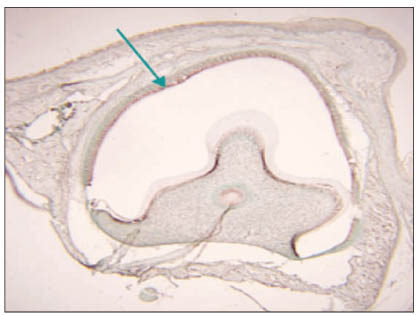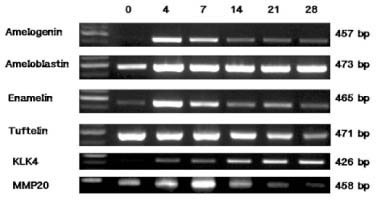Articles
- Page Path
- HOME > Restor Dent Endod > Volume 31(6); 2006 > Article
- Original Article Expression and function of OD314, Apin protein during ameloblast differentiation and amelogenesis
- Jong-Tae Park1, Yong-Seok Choi1, Heung-Joong Kim1, Moon-Jin Jeong1, Hyun-Ju Oh1, In-Cheol Shin1, Joo-Cheol Park1, Ho-Hyun Son2
-
2006;31(6):-444.
DOI: https://doi.org/10.5395/JKACD.2006.31.6.437
Published online: November 30, 2006
1Department of Oral Histology, College of Dentistry, Chosun University, Korea.
2Department of Conservative Dentistry, School of Dentistry, Seoul National University, Korea.
- Corresponding author: Ho-Hyun Son. Department of Conservative Dentistry, School of Dentistry, Seoul National University, 22 Yeongun-dong, Chongro-gu, Seoul, Korea. Tel: 82-2-2072-2652, Fax: 82-2-2072-3859, hhson@snu.ac.kr
• Received: August 24, 2006 • Revised: September 19, 2006 • Accepted: September 20, 2006
Copyright © 2006 Korean Academy of Conservative Dentistry
- 640 Views
- 0 Download
Abstract
-
This study was aimed to elucidate the biological function of OD314 (Apin protein), which is related toameloblast differentiation and amelogenesis. Apin protein, calcifying epithelial odontogenic (pindborg) tumors (CEOTs)-associated amyloid, were isolated from CEOTs, and has similar nucleotide sequences to OD314. We examined expression of the OD314 mRNA using in-situ hybridization during tooth development in mice. Expression of OD314 and several enamel matrix proteins were examined in the cultured ameloblast cell line up to 28 days by reverse transcription-polymerase chain reaction (RT-PCR) amplification. After inactivation and over-expression of the OD314 gene in ameloblast cell lines using U6 vector-driven RNA interference and CMV-OD314 construct, RT-PCR were performed to evaluate the effect of the OD314 during amelogenesis.The results were as follows:1. In in-situ hybridization, OD314 mRNAs were more strongly expressed in ameloblast than odontoblast.2. When ameloblast cells were cultured in the differentiation and mineralization medium for 28 days, the tuftelin mRNA expression was maintained from the beginning to day 14, and then gradually decreased to day 28. The expressions of amelogenin and enamelin were gradually decreased according to the ameloblast differentiation.3. Inactivation of OD314 by U6-OD314 siRNA construct down-regulated the expression of OD314, MMP-20, and tuftelin, whereas over-expression of OD314 by CMV-OD314 construct up-regulated the expression of OD314 and MMP-20 without change in tuftelin.These results suggest that OD314 is considered as an ameloblast-enriched gene and may play the important roles in ameloblast differentiation and mineralization.
- 1. Mina M, Kollar EJ. The induction of odontogenesis in non-dental mesinchyme combined with early murine mandibular arch epithelium. Arch oral Biol. 1987;32: 123-127.PubMed
- 2. D'souza RN, Cavender A, Sunavala G, Alvarez J, Ohshima T, Kulkarni AB, Macdougall M. Gene expression patterns of murine dentin matrix protein 1(Dmp1) and dentin sialophosphoprotein(DSPP) suggest distinct developmental functions in vivo. J Bone Miner Res. 1997;12: 2040-2049.ArticlePubMedPDF
- 3. Bei M, Stowell S, Maas R. Msx2 controls ameloblast terminal differentiation. Dev Dyn. 2004;231: 758-765.ArticlePubMed
- 4. Millar SE, Koyama E, Reddy ST, Andl T, Gaddapara T, Piddington R, Gibson CW. Over- and ectopic expression of Wnt3 causes progressive loss of ameloblasts in postnatal mouse incisor teeth. Connect Tissue Res. 2003;44: 124-129.ArticlePubMed
- 5. Smith CE. Cellular and chemical events during enamel formation. Crit Rev Oral Biol Med. 1998;9: 128-161.PubMed
- 6. Wang XP, Suomalainen M, Jorgez CJ, Matzuk MM, Werner S, Thesleff I. Follistatin regulates enamel patterning in mouse incisors by asymetrically inhibitting BMP signalling and ameloblast differentiation. Dev Cell. 2004;7: 719-730.PubMed
- 7. Dey R, Son HH, Cho MI. Isolation and partial sequencing of potentially odontoblast-specific/enriched rat cDNA clones obtained by suppression subtractive hybridiztion. Arch Oral Biol. 2001;46: 249-260.PubMed
- 8. Kim DH, Kim HJ, Jeong MJ, Son HH, Park JC. Expression and functional characterization of odontoblast-derived gene: OD314. J Korean Acad Conserv Dent. 2004;29(4):399-408.Article
- 9. Kim HJ, Jeong MJ, Son HH, Park JC. Inactivation of the OD314 Gene by RNA Interference in Preodontoblast Cell Lines. Korean J Phys Anthropol. 2004;17(2):121-129.ArticlePDF
- 10. Park JC, Kim IH, Kim HJ, Jeong MJ, Oh HJ, Jeong JO, Son HH. Role of OD314 During Odontoblast Differentiation. Korean J Phys Anthropol. 2005;18(3):187-196.
- 11. Solomon A, Murphy CL, Weaver K, Weiss DT, Hrucic R, Eulitz M, Donnell RL, Sletten K, Westermark G, Westermark P. Calcifying epithelial odontogence (Pindborg) tumor-associated amyloid consists of a novel human protein. J Lab Clin Med. 2003;142(5):348-355.PubMed
- 12. Garant PR. Oral cells and tissues. 2003;Chicago, IL: Quintessence publishing Co., Inc.; 25-52.
- 13. Nancy A. Ten Cate's oral histology: development, structure, and function. 2003;6th ed. St. Louis, MI: Mosby, Inc; 192-239.
- 14. Nakata A, Kameda T, Nagai H, Ikegami K, Duan Y, Terada K, Sugiyama T. Establishment and characterization of a spontaneously immortalized mouse ameloblast-lineage cell line. Biochem Biophys Res Commun. 2003;308: 834-839.ArticlePubMed
- 15. Begue-Kirn C, Krebsbach PH, Bartelett JD, Butler WT. Dentin sialoprotein, dentin phoshoprotein, enamelysin and ameloblastin: tooth-specific molecules that are distinctively expressed during murine dental differentiation. Eur J Oral Sci. 1998;106: 963-970.PubMed
- 16. Fukae M, Tanabe T. Degradation of enamel matrix proteins in porcine secretory enamel. Connect Tissue Res. 1998;39: 123-129.PubMed
- 17. Hu JC, Ryu OH, Chen JJ, Uchida T, Wakida K, Murakami C. Localization of EMSP 1 expression during tooth formation and cloning of mouse cDNA. J Dent Res. 2000;79: 70-76.ArticlePubMedPDF
- 18. Sui G, Soohoo C, Affar EB, Gay F, Shi Y, Forrester WC, Shi Y. A DNA vector-based RNA: technology to suppress gene expression in mammalian cells. Proc Natl Acad Sci. 2002;99: 5515-5520.PubMedPMC
- 19. Bartlett JD, Simmer JP, Xue J, Margolis HC, Moreno EC. Molecular cloning and mRNA tissue distribution of a novel matrix metalloproteinase isolated from porcine enamel organ. Gene. 1996;183: 123-128.ArticlePubMed
- 20. Bartlett JD, Beniash E, Lee DH, Simith CE. Decreased mineral content in MMP-20 null mouse enamel is prominent during the maturation stage. J Dent Res. 2004;83(12):909-913.PubMed
- 21. Luo W, Wen X, Wang H, MacDougall M, Snead ML, Paine ML. In vivo overexpression of Tuftelin in the enamel organic matrix. Cells Tissues Organs. 2004;177: 212-220.ArticlePubMedPDF
REFERENCES
Figure 1

Maxillary molar of 1-week-old mouse hybridized with antisense cRNA probes of OD314. Intense signal for OD314 mRNA is detected in ameloblast (arrow).

Figure 3

RT-PCR amplification of enamel matrix proteins in the cultured ameloblast cell line up to 28 days.

Figure 4

RT-PCR amplification of OD314 in ameloblast cell line after over-expression with CMV-OD314 plasmid and inactivation with U6-OD314 siRNA.

Tables & Figures
REFERENCES
Citations
Citations to this article as recorded by 

Expression and function of OD314, Apin protein during ameloblast differentiation and amelogenesis





Figure 1
Maxillary molar of 1-week-old mouse hybridized with antisense cRNA probes of OD314. Intense signal for OD314 mRNA is detected in ameloblast (arrow).
Figure 2
RT-PCR amplification of OD314 in the cultured ameloblast cell line up to 28 days.
Figure 3
RT-PCR amplification of enamel matrix proteins in the cultured ameloblast cell line up to 28 days.
Figure 4
RT-PCR amplification of OD314 in ameloblast cell line after over-expression with CMV-OD314 plasmid and inactivation with U6-OD314 siRNA.
Figure 5
RT-PCR amplification of matrix protein in ameloblast cell line after over-expression with CMV-OD314 plasmid and inactivation with U6-OD314 siRNA.
Figure 1
Figure 2
Figure 3
Figure 4
Figure 5
Expression and function of OD314, Apin protein during ameloblast differentiation and amelogenesis
Nucleotide sequences of the primers used for RT-PCR
Table 1
Nucleotide sequences of the primers used for RT-PCR

 KACD
KACD



 ePub Link
ePub Link Cite
Cite

